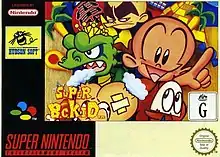Super Bonk
Super Bonk (released in Europe as Super B.C. Kid and in Japan as Super Genjin) is a 1994 platform video game developed by A.I. Co, Ltd. and Red Company and published by Hudson Soft for the Super Nintendo Entertainment System. It is the fourth game in the Bonk series. The game was later re-released for the Wii Virtual Console in Japan on November 16, 2010, in Europe on December 10, 2010, and in North America on April 4, 2011.[2][3][4]
| Super Bonk | |
|---|---|
 SNES Oceania box art | |
| Developer(s) | A.I. Co, Ltd. Red Company |
| Publisher(s) | Hudson Soft |
| Director(s) | Shoichi Yoshikawa |
| Producer(s) | Norihito Miyamoto |
| Composer(s) | Masaaki Nishizawa Keiji Ueki Kennosuke Suemura |
| Series | Bonk |
| Platform(s) | Super Nintendo Entertainment System |
| Release | |
| Genre(s) | Platform |
| Mode(s) | Single-player |
Gameplay
The fourth game in the regular Bonk series, Bonk is back on his first Super Nintendo Outing in this side scrolling adventure. The gameplay is similar to Bonk 3. Super Bonk allows Bonk to travel through time from his prehistoric levels to the insides of a dinosaur, a version of modern Chinatown, and the moon. Along the way, Bonk can find power ups that can change his form to creatures, such as a shooting Bonk Crab a dinosaur form called Big Kronk find candies that change his size from tiny to huge travel through transportation tubes and find multiple bonus levels. Bonk stills use his head to smash his enemies propeller seeds that allow bonk to fly and for the first time can carry flowers on his head in his continuing battle against his arch nemesis King Drool.
Reception
| Aggregator | Score |
|---|---|
| GameRankings | 71.50% (4 reviews)[5] |
In their review, GamePro praised the clever usage of Bonk's various forms, the "crisp, cutesy quality" of the graphics, the easy controls, and the numerous bonus rounds, but nonetheless gave Super Bonk an overall negative assessment, concluding that platformer fans in general and Bonk fans in particular would find very little new content about the game.[6] In 1995, Total! ranked Super Bonk 44th on its Top 100 SNES Games, summarizing: "Despite slightly awkward controls this is an amusing, well crafted and gripping platformer. It’s also very original in places."[7]
References
- Nintendo staff. "Super NES Games" (PDF). Nintendo. Archived from the original (PDF) on June 14, 2011. Retrieved September 24, 2011.
- "バーチャルコンソール | ダウンロードゲーム | 株式会社ハドソン". May 28, 2011. Archived from the original on May 28, 2011. Retrieved July 22, 2022.
- "Super Bonk". Nintendo of Europe GmbH. Retrieved July 22, 2022.
- "Super Bonk at Nintendo :: Games". April 11, 2011. Archived from the original on April 11, 2011. Retrieved July 22, 2022.
- "Super Bonk review score". Archived from the original on May 3, 2019.
- "ProReview: Super Bonk". GamePro. No. 67. IDG. February 1995. p. 62.
- "Top 100 SNES Games". Total! (43): 45. July 1995. Retrieved March 2, 2022.
External links
- Super Bonk at The Bonk Compendium (covering all games and references to Bonk series)
- Super Bonk / Super Genjin at Hardcore Gaming 101